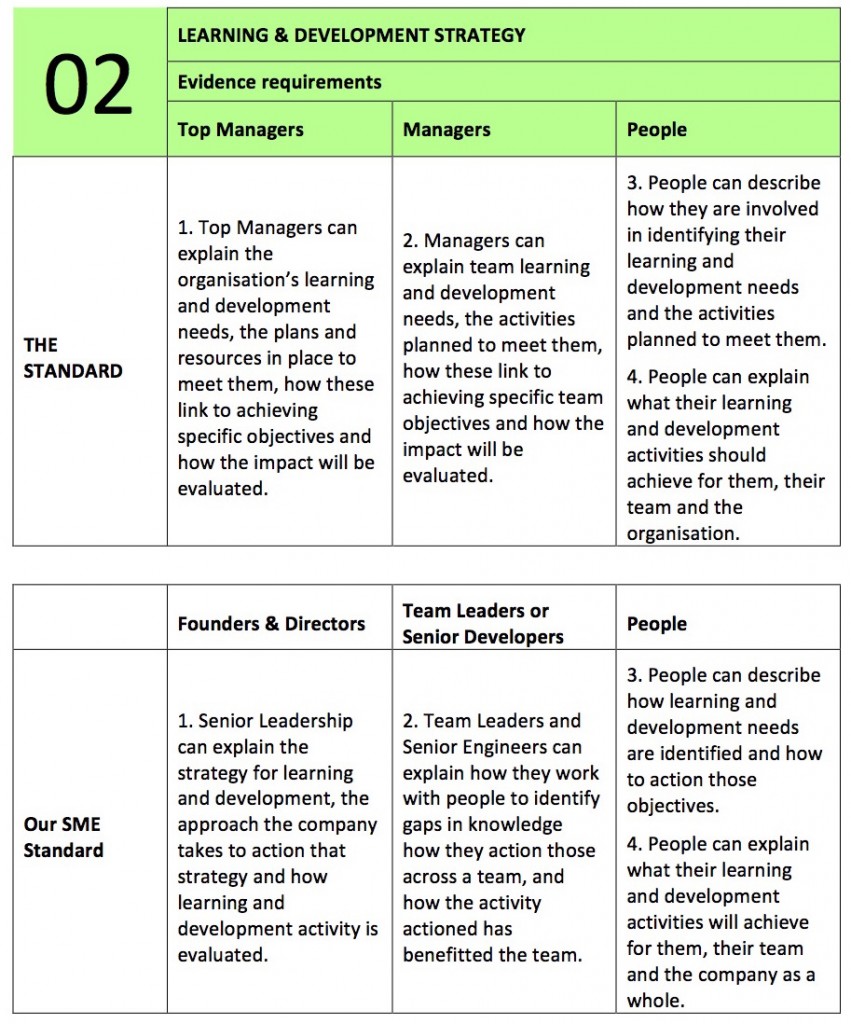One SMEs voyage into the world of the ‘Investors in People’ accreditation has begun. The groundwork has been done (read how the journey began Investors in People and SMEs: a match not made in heaven and then the next step Investors in People: the standards and the lingo) and the first steps taken. We tackled Strategy 02: Learning and Development.
Our journey started with understanding what the standard says, what that might look like for a tech start-up (using the terms outlined here), and how we (at Surevine) measure up.
I do not expect us to be achieving the standard across the board – but that’s ok. We are a learning organisation and an open one at that; we can be proud of the areas that still need work, because we are doing something about it; in the open.
02: Learning & Development
As I said in my last post, with People at the heart of Surevine, my journey will begin with the Learning and Development Strategy.
The Breakdown
How we measure up
 1. Strategy: Our Senior Leadership Team (SLT) working with Talent Management, and consulting everyone, set the strategy for learning and development across the company; we work out what ‘great’ would look like, and then plan how to get there. Approach: The SLT set a target of a minimum threshold of two whole weeks per year for everyone to spend on learning and development; outside of the learning we do every day on the job. They trust the team to work with Talent Management and action their own objectives, and request financial approval as/when needed. Evaluation: Each member of the core team has a personal Wiki page that lists their skills (“ask me about…”) and their learning and development areas of focus. This is out in the open for all the team to see, and records all the learning and development activity that is undertaken…so we are getting there. But, we don’t evaluate this (as yet), other than confirming at the end of the year how many of those dedicated days have been taken. This is a relatively new way-of-working for us, so I will take an action to explore how we evaluate the actual activity.
1. Strategy: Our Senior Leadership Team (SLT) working with Talent Management, and consulting everyone, set the strategy for learning and development across the company; we work out what ‘great’ would look like, and then plan how to get there. Approach: The SLT set a target of a minimum threshold of two whole weeks per year for everyone to spend on learning and development; outside of the learning we do every day on the job. They trust the team to work with Talent Management and action their own objectives, and request financial approval as/when needed. Evaluation: Each member of the core team has a personal Wiki page that lists their skills (“ask me about…”) and their learning and development areas of focus. This is out in the open for all the team to see, and records all the learning and development activity that is undertaken…so we are getting there. But, we don’t evaluate this (as yet), other than confirming at the end of the year how many of those dedicated days have been taken. This is a relatively new way-of-working for us, so I will take an action to explore how we evaluate the actual activity.
2. For Surevine, as a technology SME, the responsibility here depends on the particular part of the business; technical teams, for example, are guided by our Senior Engineers. However, not all Senior Engineers are ‘guiders of people’ and want to lead projects – we know that some of our Senior folk are Senior because of their expert knowledge, not their desire to lead. Anyway… Identifying knowledge gaps: All Senior Engineers that lead teams, working with our SLT, know that when a gap in knowledge is identified they can make the necessary action happen. If internal skill sharing is needed, they can help the individual to get the knowledge from someone in the team that already has it; alternatively, if external training is needed, they talk to Talent Management who will work with the individual to help them get the necessary training. Team benefit: The Senior Engineer or SLT member will understand and therefore be able to identify the benefit of the learning and development activity undertaken to the rest of that team/function. If the benefit isn’t being felt, then the learning and development objective isn’t done!
3. Identifying needs: Learning and development objectives are identified either through a tactical need (often by a peer in their self-managed team) or as part of the employee’s annual performance review. Action: Talent Management work with each employee as they become a core member of the team (pass probation) to carve out time for learning and development, and how to take action on their identified learning objectives.
 4. All employees understand what their learning and development objectives will achieve for them (principally because they helped to identify them!), how this learning will benefit the team (because our small teams are self-managed and therefore all operations are open and visible to them) and importantly how their learning will benefit Surevine; because being part of a small company, it’s easier to see how it will impact the whole business.
4. All employees understand what their learning and development objectives will achieve for them (principally because they helped to identify them!), how this learning will benefit the team (because our small teams are self-managed and therefore all operations are open and visible to them) and importantly how their learning will benefit Surevine; because being part of a small company, it’s easier to see how it will impact the whole business.
The results
Well, so far so good! We have 1 action to take away, but it looks like for this bit of the standard we are doing A-OK.
Let’s see what the next part of the standard, People Management, brings us.
